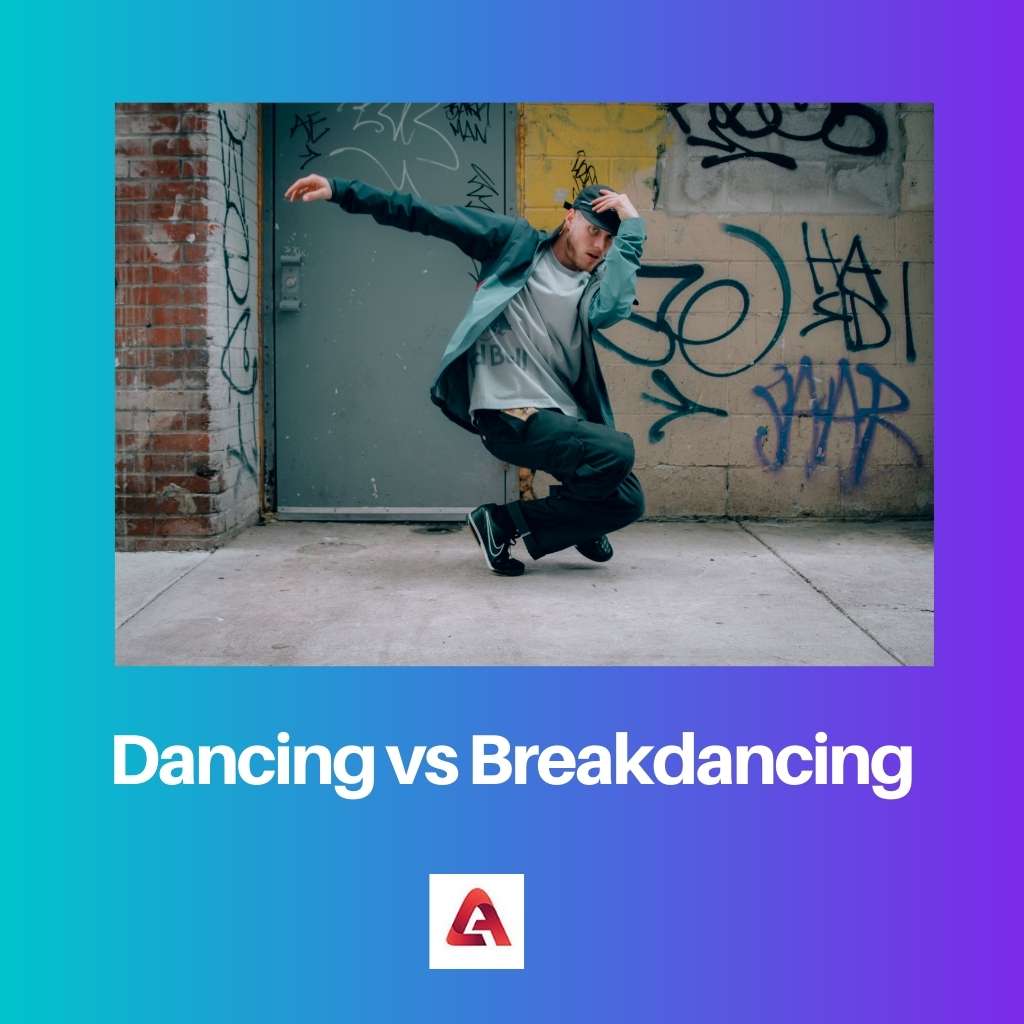Music and movement relieve stress and pain and pure art form to express emotions or stories. It is not specific to any age group and enjoyed by all.
Dancing could be a way to introduce discipline in young children. Dance or breakdance is a form of art, moving rhythmically to music and following a set sequence of steps.
Key Takeaways
- Dancing is a broad term for various types of movement set to music, while breakdancing is a specific type of dance that involves acrobatic moves.
- Breakdancing is more physically demanding than dancing.
- Dancing is performed in groups, while breakdancing is performed solo.
Dancing vs Breakdancing
Dancing is an art form related to body movements and expresses feelings and emotions. A lot of patience and time is required to learn any dance form. Breakdancing gets commonly referred to as B-boys or B-girls. Breakdancing requires a good fitness level and the highest musculoskeletal injury.

Dancing is a performing art that involves sequences of movements. Generally, the flow is predecided(choreography) and improvised by the dancer.
Dancing has been around for 1000’s years, and there are many dance genres in the modern-day. Many dance forms adapt to strict choreography, and some are open to evolvement.
Dancing is a popular form and does not restrict any age group or sex.
Breakdancing is a street dance that originated from African American and Puerto Rican communities in the United States. Breakdancing involves drum beats, hip-hop, funk, soul music, and breakbeat music.
Breakdancing even harness negative feedback as the use of derogatory. Breakdancing does come into mainstream dancing, ‘b-boying’ and breaking are the original terminologies.
Comparison Table
| Parameters Of Comparison | Dancing | Breakdancing |
|---|---|---|
| Develop | Dancing developed over the centuries. | Developed during the 1970s. |
| Form | Expression of emotions. | It is street culture. |
| Music | Based on the dance form. | Based on a drum beat, hip hop, and fun. |
| Genre | There are many forms of genre used. | It is a form in itself. |
| Meaning | It is a form of art. | It is considered inappropriate. |
What is Dancing?
Dance is a form of expression and movement to express an idea, story, or emotion. Dancing is a blend of motion of the entire body and facial expression.
Dance is a universal art form, and different parts of the world have their popular dance form.
There is a crucial difference between sports and dance, and there are no scoring points or winners. It is a pure expression of self. A dancer takes care of the moves than the final score.
Dance gets accompanied by music, and the tempo plays a crucial role. The rhythm helps in conveying the message.
Elements of Dancing:
- Space
- Time
- Force
- Body
These elements get incorporated into different speeds, shapes, rhythms, and directions. When the dancer moves from one end of the stage to the other, they evoke numerous expressions.
The movement gestures expressions. When a dancer portrays shyness, the motion could be close to their body and show a confined space.
This utilization of space and movement speaks volumes.
History of Dancing:
The oldest proof of dancing is existent in caves of India dating back 9000 years. It portrayed scenes from communal drinking and religious ceremonies with the dance scene.
The Egyptian culture showed the priests utilizing musical instruments and dance to showcase important events, stories of gods, cosmic patterns. In Greece, dancing was part of the celebration before the Olympics in the 8th century.
There are many dance genres in today’s society, and they utilize a piece of specific music or tempo, and they could have strict choreography of are open to interpretation.
Dancing contains everything from the eye-catching display, forms of movement, and the messages it conveys.

What is Breakdancing?
Breakdancing is a street dance that is athletic, energetic, improvised, and it has elements like top rock, drop, down rock, power moves, and freeze. Breakdancing is considered pop culture but can be offensive.
In the 1980s Breakdancing, came into existence, referred to as unrelated moves. Popping and locking became popular in Los Angeles around the same time.
History of Breakdancing:
The birth of breaking gets dedicated to DJ Kool Herc in early 1970. Percussive, heavy bass and funky music were the souls to Breakdancing.
By the late 1970s, hip-hop culture was in full swing in the New-York City. Today the breaking community exists across the globe, and there are many international competitions heald.
Main elements of Breakdancing:
- Toprock-These are steps performed while standing, and it is the basic all dancers perform before transitioning into other forms. It is a visual break between standing, footwork, and floorwork.
- Downrock-These are steps performed on the ground with the support of feet or hands.
- Drops-This is a sequel between top rock and down rock. The b-boys or b-girls drop to the floor and create visual elements.
- Power moves-It is a martial art-inspired acrobatic move that relies on power and momentum.
- Freezes-This requires balance and strength. Freeze incorporates strong beats and marks the end of a set.

Main Differences Between Dancing and Breakdancing
- Dancing has been around for centuries. Breakdancing got developed in the early 1970s.
- Dancing uses movement to express ideas or emotions. Breakdancing is a street culture with a lot of energy.
- Dancing involves the use of different music tempos based on the dance style. Breakdancing utilizes drum beats, hip-hop, funk, soul music, and breakbeat music.
- Dancing is a pure form of art. Breakdancing pop culture could be contemplated as inappropriate.
- Dancing involves many genres in this modern time. Breakdancing is a form by itself.

- https://link.springer.com/content/pdf/10.1057/9780230626485.pdf
- https://www.cambridge.org/core/journals/dance-research-journal/article/global-breakdancing-and-the-intercultural-body/13649BEAABFEFDBE0917A8B26C1F1430
